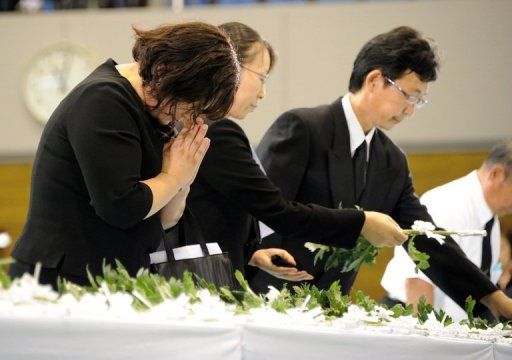You are here
Japan Today - September 11, 2011

The March 11 earthquake and tsunami in Japan left 20,000 dead or missing and sparked a nuclear crisis. AFP
MINAMISANRIKU —
The people of Japan fell silent in prayer on Sunday, six months after an earthquake and tsunami left 20,000 dead or missing and sparked a nuclear crisis.
At 2:46 p.m. the eerie wail of warning sirens rang out, marking exactly six months since the the 9.0-magnitude quake struck, unleashing towering waves which swallowed whole communities.
In towns along the devastated Pacific coastline, mourners gathered to remember the dead, while in Tokyo anti-nuclear rallies were held over the Fukushima crisis—the worst nuclear accident since the 1986 Chernobyl disaster.
In the coastal town of Minamisanriku, where 900 people were killed and 60% of the buildings were destroyed, about 2,000 people dressed in black gathered at a public gymnasium to observe a moment’s silence.
“We never give up hope and vow to unite as one in building a new town so that we can make up for the sacrifice of precious lives of many people,” Minamisanriku mayor Jin Sato said during the remembrance service.
The March 11 quake struck 130 kilometers offshore and sent giant waves along a 600-kilometer stretch of the scenic northeast coast.
The disaster also crippled cooling systems and sparked meltdowns at the Fukushima Daiichi plant, some 220 kilometers northeast of Tokyo, forcing tens of thousands to evacuate, still with no idea when they can return home.
“The most difficult thing is that I have lost my job and it is hard to work out plans for my children,” Takahiro Murakami, 35, told AFP in Minamisanriku. “The biggest shock was to see my town disappear.”
In the major fishing port of Ishinomaki, where 4,000 people lost their lives in the tsunami, people gathered on a hill overlooking the town below where mounds of debris and wrecked vehicles littered the waterfront.
As the sirens wailed out they folded their hands and prayed.
Meanwhile, about 1,000 people, including many families, marched through the trendy Tokyo streets of Shibuya. Children held placards which read: “No Nukes.”
Two similar major anti-nuclear rallies were staged in the capital, including the formation of a human chain around the the economy ministry, which is responsible for nuclear power.
Rebuilding the muddy wastelands of the northeastern Tohoku region is expected to cost hundreds of billions of dollars and take up to a decade.
Areas close to the Fukushima Daiichi nuclear plant may be uninhabitable for even longer.
Radiation fears became a feature of daily life after cases of contaminated water, beef, vegetables, tea and seafood. But the government has been at pains to stress the lack of an “immediate” health risk.
http://www.japantoday.com/category/national/view/silence-as-japan-marks-six-months-after-tsunami



Recent Comments